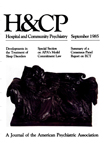Preventing Rehospitalization of Clients in a Psychosocial Rehabilitation Program
Abstract
Psychosocial rehabilitation programs are known for their pragmatism and flexibility. They have tackled the problem of recidivism by borrowing techniques from successful programs (regardless of theoretical orientation), relying on trial and error or clinical hunches, and utilizing the findings of internal program evaluations. The proliferation of newer psychosocial technologies and the increased recidivism of the past decade suggest a need to reevaluate existing programs. We need to examine what methods work with particular clients in order to provide a continuum of care for a heterogeneous client population.
Access content
To read the fulltext, please use one of the options below to sign in or purchase access.- Personal login
- Institutional Login
- Sign in via OpenAthens
- Register for access
-
Please login/register if you wish to pair your device and check access availability.
Not a subscriber?
PsychiatryOnline subscription options offer access to the DSM-5 library, books, journals, CME, and patient resources. This all-in-one virtual library provides psychiatrists and mental health professionals with key resources for diagnosis, treatment, research, and professional development.
Need more help? PsychiatryOnline Customer Service may be reached by emailing [email protected] or by calling 800-368-5777 (in the U.S.) or 703-907-7322 (outside the U.S.).



